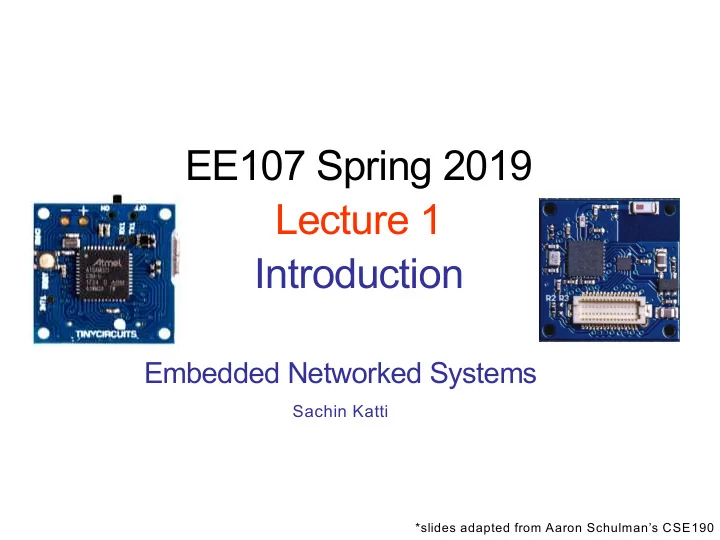

EE107 Spring 2019 Lecture 1 Introduction Embedded Networked Systems Sachin Katti *slides adapted from Aaron Schulman’s CSE190
EE107: Embedded Networked Systems Goal: Provide a hands on introduction to the design of wireless embedded systems. Class will focus broadly on how to design a fully functional wireless embedded system. By the end of the course, you should be able to operate in a team that is building a product around an embedded system.
Logistics • Instructors: Sachin Katti • CA: Pan Hu • Lectures: Mon/Wed 4:30-5:20pm • Lab: Fri 4:30-5:20pm • Office hours: – Sachin: TBD – Pan: TBD • Web: • Course website: http://web.stanford.edu/class/ee107/ • Discussion Forum: https://piazza.com/stanford/spring2019/ee107/home#
Lectures & Assignments • Lecture slides will be posted on the course website • Four assignments, submit via piazza – Blinkenlight communication: GPIO, timer (Due Apr 15) – Interfacing with peripherals: I2C (Due Apr 26) – Making your battery to last a month: clocks (Due May 8) – BLE proximity detection: wireless (Due May 17) • Assignments will be based on programming – Important to do them to keep pace in class
Project & Exams • Final project: build a battery-powered embedded sensor that transmits data to a smartphone. – Project proposal due May 1 – Project demo at the end of quarter (June 5) • One midterm exam in class (second week of May) – Exam: in class, date TBD – No final 5
Grading Logistics • Overall Class Grade – Exam: 30% – Four Assignments: 40% – End of quarter project: 30%
Lab Safety • Carefully read lab safety training: https://stanford.app.box.com/v/Basic-Lab-Safety – Being safe themselves and not endangering others by their actions • Register and complete EHS4200 AND EHS 3400 (each takes about one hour): – https://ehs.stanford.edu/training/ehs-4200- general-safety – https://ehs.stanford.edu/training/ehs-3400- ergonomics-computer-workstation
Lab Safety • Verify you’ve completed training in AXESS 1 2 3 4
What is a wireless embedded system? • Computing systems are everywhere • Most of us think of “desktop” computers – PC’s – Laptops – Mainframes – Servers • But there’s another type of computing system – They are far more common... 9
Wireless embedded systems: the center of the next generation of computing (i.e., Internet of Things) 1 0
The components of the IoT revolution Embedded systems Analog Systems Digital Systems Tiny MEMS sensors Programmable Inexpensive computation Microcontrollers Tiny sensors Tiny RF Easy-to-use frameworks Integrated Circuits Wireless networks 1 1
Wireless Embedded Systems – Computing systems embedded within things/gadgets connected to the Internet – Hard to call out any one thing/gadget, nearly everything now has a chip and a radio in it – Billions of units produced yearly, versus millions of desktop/laptop units 12
Examples of wireless embedded systems Amazon Echo (Alexa) – Voice Assistant 8x microphone array WiFi/Bluetooth Microcontroller/DSP
Examples of wireless embedded systems Fitbit – Fitness Tracker Battery Accelerometer Microcontroller Barometer Bluetooth Radio Vibration Motor 14
Examples of wireless embedded systems Bird – Sharing Economy Scooter Particle Board: Microcontroller + Bluetooth + GSM (Cellular) 15
Typical Microcontroller 1 6
YouSense : Your personal battery-powered sensor • Hardware – MCU that collects vision data from sensors – Bluetooth Low-Energy to transmit data to a smartphone – Flash memory to persistently store data – Battery powered for several days to months. • Software in a smartphone – Display sensor measurements – AI and machine learning for processing the sensor data – Connection to cloud services
What will you take away from this project? • General knowledge of how an embedded system works – GPIO, Clocks, Interrupts, DMA, ADC, SPI, I2C, UART • Low-level firmware development in C – Device drivers – Digital signal processing • Hardware testing (and building) – Reading circuit layout and schematics – Analog circuit measurement (Oscilloscope, Multimeter) – Digital logic observation (Digital Logic Analyzer)
YouSense Hardware Platform TinyZero (ARM Cortex M0+) Battery powered microcontroller, Bluetooth Low Energy, many sensors. 1 9
Potential YouSense Projects • Your ideas are GREAT! – Propose and implement a cool application – Propose and implement something to make the system faster, more reliable or more power-efficient • Anti spy-device shield – Detect nearby Bluetooth devices that are spying on you (e.g., collecting personal data)… this is a real problem! • Lost item detector – Attaches to an item (e.g., backpack) and tells any nearby smartphone when it thinks it is “lost”. • Think about what you could do with: – Sensors: IMU, temperature, humidity, pressure, light, GPS – Actuators: motor, servo, LED, speaker – Communication: WiFi, Bluetooth, 2.4G/433MHz proprietary
Recommend
More recommend